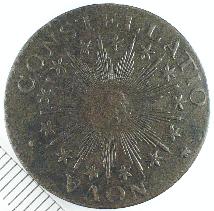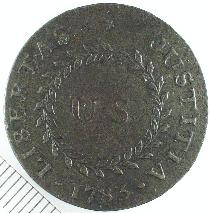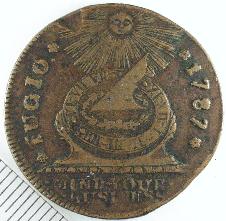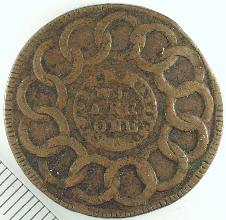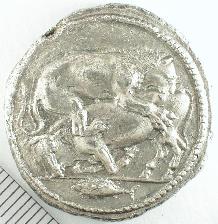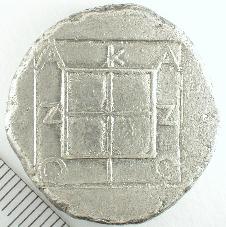Chatter
archive
also available
| Chicago Coin Club |
|---|
| Volume 51 No. 6 |
June 2005 |
|---|
Minutes of the 1037th Meeting
The 1037th meeting of the Chicago Coin Club was called to order May 11, 2005 at 7:00 PM
by President Robert Feiler with 16 members in attendance. The meeting was held in a new
spacious meeting room at Dearborn Center, 131 S. Dearborn, 6th Floor Conference Room
6C. President Feiler thanked members Lyle Daly, Jeff Rosinia and Chuck Jacobs for their
work and efforts in obtaining the room and they were given a warm round of applause.
The April Minutes as published in the Chatter were approved as published.
Steve Zitowsky treasurer's April report of $206 in revenue, expenses of $424.70
and total assets of $7,697.86 was approved.
First V.P. Jeff Rosinia introduced the evening's featured speaker Chuck Jacobs who spoke on
Die Struck Copper Coins of China.
Second V.P. Lyle Daly introduced the evening's exhibitors: DON DOOL - seven different
General San Martin medals; ROBERT LEONARD - report on his research into
counterfeit silver dollars made of silver and his article recently published in Coin World,
two books purchased at the Medieval Conference in Kalamazoo, Michigan; MARK
WIECLAW - a Chinese snuff bottle made from agate with a coin design, a 1783 Nova
Constellatio cent, a 1787 Fugio cent, a tetradrachm from Akanthus (480-424 B.C.) with
unpublished dies of a lion attacking a bull, and comic coins issued by Nat'l. San. Labs, 6652
N. Western, Chicago 45, Illinois; RICHARD HAMILTON - a $1,000 bond from the Beech
Creek Railroad and issued in 1892; ROBERT WEINSTEIN - a bronze coin from the
Kingdom of Tylis and the Indo-Greek Kingdom, 2 coins from the Byzantine Empire and a
fake wooden nickel of Vee Jay Records, Chicago; and ROBERT FEILER - 5 different
Mexican reales authenticated by last month's speaker Clyde Hubbard.
President Feiler presented the Club's engraved 50-year membership medal from Central
States Numismatic Society to William Burd, Club Archivist. Burd was also given serial no.
1 of the recently produced souvenir cards for the Chicago Paper Money Expo (CPMX) and
the Chicago International Coin Fair. Jeff Rosinia, the author of the CPMX souvenir card
was presented with serial no. 3 of the issue.
Jeff Rosinia delivered a brief overview of the membership survey taken in 2004. Robert
Weinstein delivered video tapes holding member interviews recorded in 1994 that would be
turned over to Jeff Rosinia, who has video editor contacts.
President Feiler brought up for discussion a list of discussed items from the recently held
Board of Directors meeting. Subjects included the creation of an updated tri-fold brochure
introducing the Club, Daly and Rosinia volunteered to investigate a new design;
advertising in The Chatter; a new book project; dropping member's last names in the
Chatter; a site for the December 14th annual banquet; restarting coin discussion group
meetings on the 4th Wednesday that received positive feedback; the archivist writing a 25,
50 and 75 years ago column for the Chatter; exhibitors were asked to watch the length of
their exhibits and a suggestion was made for members to transform some exhibits into
mini-featured talks.
The meeting was adjourned at 9:17 PM
Respectfully submitted, Carl Wolf
Secretary
Speaker's Wor[l]d
Die-Struck Copper Coinage of China
Presented by Chuck Jacobs to our May 11, 2005 meeting.
Until late in the 19th century,
the most common Chinese coin was the cash piece
which was round with a square hole.
Struck coins appeared in the late 1880s
but were not common until about 1902.
From 1900 to 1917, about 32 billion of the 10 cash coins were made;
this talk concentrated on those coins.
Chuck started his presentation with a review of
Chinese history from the late Qing Dynasty
through the early Republic era.
The 10 cash coin (worth about 1 US cent, but the value varied over time),
was the most popular coin of the period.
The diameter varied from 28 to 29.5 mm,
and the weight from 95 to 124.5 grains (115 on average).
Laid out together,
a 10 cash coin, a US Large Cent, and a British Penny
are all about the same size.
This copper coinage started in the provinces:
the Peiyang mint in 1888,
and then the Kwantung mint in 1889.
By 1906, the central government and 17 provinces were striking coins.
The coinage was valued by metal and weight, with even slugs circulating.
Some mints would debase the coinage by adding pewter or lead;
the mints were profit enterprises,
buying the metal and keeping the seignorage.
The many coins shown during the talk provided a mere hint
of the range of varieties out there.
Two main causes of varieties were identified:
many sources for the dies, and many dies being produced.
Although most of the provinces used the dragon motif for some years,
die production was not centralized so each province had its own style of dragon.
(For example, some dies for Hunan's coins were made in Japan,
hence its similarity to the dragon on Japan's one sen coin.)
The large number of needed dies must have hard on the engravers:
we have misspelling of the English legends,
upside down letters (one displayed coin appeared to show
signs of a upside down letter under the correctly placed letter),
and differences in dragon rendition and position.
Those differences let later collectors develop such fanciful names for Hunan varieties as:
creeping dragon, comet-tail dragon, ornamented dragon,
and high-flying dragon.
Some distinguishing attributes are the number of flames on the fireball
and the location of protruding scales.
The definitive reference is A.M. Tracey Woodward's 1936 work
The Minted Ten Cash Coins of China.
Only 95 copies were made of this collection of
journal articles from the mid 1920s to the early 1930s.
Woodward was a doctor who had made his money from the opium trade;
he had up to 300 workers sorting through coins looking for new varieties.
He built the definitive collection of minted Chinese cash pieces;
5000 or so pieces.
Deciding that China was no longer safe, he and his collection moved to France.
His collection spent World War II buried somewhere in Bordeaux;
after the war, some of the finest pieces ended up in King Farouk's collection,
the mid-level pieces went to a specialist,
and the common pieces were sold cheaply in bulk lots,
destined for dealer junk boxes.
The 10 cash coin was a working coinage with the coin's aesthetics having low priority.
No attempt was made at aligning the obverse and reverse dies,
and varieties resulted when obverse and reverse dies were combined.
The strike quality varied,
and the dies were used until they wore out.
Although most coins have smooth edges,
some have milled edges.
The dragon motif from the Empire was not used often in the Republic era;
stars and flags were more commonly used.
There are very few coins with people, especially in copper.
With 193 varieties known from just Sichuan province,
there are more than Woodward's 1200 varieties out there
waiting to challenge modern collectors.
Show and Tell
Presented at our May 11, 2005 meeting.
Each image has a scale in the lower-left corner,
with the tics spaced 1 mm apart.
Because the brightness and contrast were manipulated on a computer,
the coloring of a coin's image differs from the coin's actual coloring.
-
Last month,
Don Dool
showed medals honoring monuments to San Martín.
Medals of San Martín are known in many categories,
such as centenaries, bicentenares, battles, Mason medals,
and commercial medals (usually from the 1910 centennial of the revolution).
Some of the commercial pieces Don showed were:
-
A horizontal oval with male and female lions on one side.
-
Possibly a watch fob from a camiseria (shirt factory).
-
A medal from the Corona Watch Company.
-
A watch fob commemmorating 50 years of a beverage.
-
A medal from a Bianchi (Italian) car dealership in Rosario.
A web search turned up one Bianchi for sale in Belgium,
but the picture shows a car needing some work.
-
Robert Leonard
is interested in counterfeit coins,
and he keeps a file of stories about them.
A PCGS press release announcing that they had slabbed counterfeit
US silver dollars reminded him of a reference to
articles in the New York Times;
a search of their web site yielded some articles from 1897 and 1898.
Bob wrote an article and submitted it to Coin World,
and he showed it on page 8 of the current issue.
The whole story is not yet out,
and a followup discussion touched on such topics
as how PCGS identified the counterfeits from repeated depressions
near the mint mark,
to how it was profitable to make counterfeit coins with the correct silver content.
Bob also showed two books obtained while attended
the annual Medieval Congress in Kalamazoo, Michigan:
Coinage in Syria Under Persian Rule 610-630
is in French with an English summary;
while Medieval Monney Matters, Coinage in England
recounts how England went from a non-monetary economy
to a monetary economy.
-
Mark Wieclaw
showed a carved snuff bottle before showing some coins.
-
Carved from a piece of agate (circa 1840-1870),
the Chinese snuff bottle design elements include
coins (for prosperity) and bats (for good lick).
The design elements are in the areas of variously colored imperfections
or foreign material in the agate.
-
A 1783 Nova Constellatio Cent,
with pointed rays and a large US.
-
A Fugio Cent, note the words STATES and UNITED are incuse.
-
A tetradrachm from Akanthus from 480-424 BC.
It features a lion attacking a bull, with a fish below.
It is from unpublished dies similar to Deseneux 102.
-
Two adult tokens with "Heads I Win" and "Tails You Lose" legends.
They were bought on eBay (someone phoned Mark after seeing them),
and have their original cardboard boxes from
Comic Coins, 6652 N. Western, Chicago.
They are part of a series of ten.
-
At a recent show,
Dick Hamilton
acquired a $1000 bond from the Beech Creek Railroad of New Jersey.
Printed by the American Bank Note Company, it was issued May 27, 1892,
has hand signatures, and is number 185.
It is a 4% first mortgage bond,
guaranteed by the Nw York Central and Hudson River Railroad
which later bought it.
-
Robert Weinstein
showed lesser-known items:
-
A Greek looking bronze coin issued by the Celts in Tylis during the late 3rd century BC.
-
A square bronze Indo-Greek coin of King Strato.
Greek god Apollo holds a bow and arrow on the side with a Greek legend,
while the other side has a Sanskrit-derived legend around a tripod.
Circa 130 BC, from the area now known as the northern Punjab.
-
A follis of Empress Fausta, the second wive of Constantine (the Great).
She was boiled to death after Constantine found that she had lied
to have Constantine's son by his first wife put to death.
-
A centenionalis of Constantius II from the Antioch mint.
The reverse type is a soldier spearing a fallen Persian horseman.
-
A piece of fake Chicago exonumia, appears to be
a Chicago Christmas wooden nickel of the Beatles and Vee Jay Records of Chicago.
(Vee Jay was a small label which released some early Beatles albums
when the major labels passed on them.)
But the company had moved to Los Angeles by 1964.
These showed up on the market some years ago.
-
Robert Feiler
had five of his Mexican coins attributed by Clyde Hubbard,
the speaker at or CICF meeting.
They were:
-
A 4 reales of the late series found on Padre Island,
from the 1553 fleet.
-
A 1 real of the late series, with initial of assayer L.
-
A 1731 8 reales (cob), from the fleet of 1733.
-
A 8 reales circa 1640, with initial of assayer P,
and from the 1641 Concepcion wreck.
-
A 1770 2 reales of Charles III
featuring the pillar design.
Encyclopedia of Chicago Goes on the Web
Last year many CCC members purchased the 1,100+ page
Encyclopedia of Chicago.
The volume can certainly assist when doing research on local numismatic issues.
Now the electronic version is up and working on the web.
Go to http://www.encyclopedia.chicagohistory.org/
and find many additional features not in the book.
According to the Chicago Sun-Times,
the online version has several hundred more entries,
more than 1,000 additional images,
video of historic figures and events, primary source material,
personal letters, newspaper articles, artwork, legal documents,
hyperlinks to books, interactive maps and more.
If all this material were in the book, it would run more than 10,000 pages!
And here's the best part - it's free!
Carl Wolf
Our 1038th Meeting
| Date: | June 8, 2005, First session |
| Time: | 7:00 PM |
| Location: | Downtown Chicago
At Dearborn Center, 131 S. Dearborn, 6th Floor, Conference Room 6A (right off the elevator lobby).
Please remember the security measures at our meeting building:
give a club officer the names of all your guests prior to the meeting day;
and everyone must show their photo-ID and register at the guard's desk. |
| Featured speaker: |
- to be announced |
|
|
| |
| Date: | June 25, 2005 Second session |
| Time: | 1:00 PM |
| Location: | At the MidAmerica Coin Expo,
at the Donald E. Stephens Convention Center, 5555 North River Road, Rosemont, IL.
No admission charge for our meeting. |
| Featured speaker: | David Sundman
- 19th Century 3-D Slides of the U.S. Mint |
|
Stereo photography was a popular way to view images during the 19th century.
It consisted of two separate photos that gave a 3-dimensional effect
when superimposed and viewed through special glasses.
David Sundman acquired a selection of stereophotos showing the U.S. Mint
during the 1800s and has converted them into a slide program.
David Sundman will lead this educational tour back in time when the Mint
was striking Indian cents, Shield nickels, and Seated Liberty coinage.
Those who attend will be given a special pair of viewing glasses and, while supplies last, a bag of popcorn.
|
Important Dates
| Our June meeting will consist of two sessions:
we will end the first session with a recess (instead of an adjournment),
and we will reconvene for the second session at the Chicago International Coin Fair. |
| June |
8 |
CCC Meeting - Featured Speaker - to be announced |
| June |
24-26 |
MidAmerica Coin Expo
at the Donald E. Stephens Convention Center, 5555 North River Road, Rosemont, IL.
Admission is $5. |
| June |
25 |
CCC Meeting - 1pm at the MidAmerica Coin Expo,
which is held at the Donald E. Stephens Convention Center, 5555 North River Road, Rosemont, IL.
No admission charge for our meeting.
Featured Speaker - David Sundman on 19th Century 3-D Slides of the U.S. Mint |
| |
| July |
13 |
CCC Meeting - Featured Speaker - Sharon Blocker on Collecting Polymer Banknotes |
| |
| August |
10 |
CCC Meeting - Featured Speaker - to be announced |
Birthday and Year Joined
| July |
4 |
Chester Poderski |
| July |
12 |
Flemming Lyngbeck Hansen |
2000 |
| July |
13 |
Gerard Anaszewicz |
1981 |
| July |
19 |
Terry L. Capps |
1996 |
| July |
19 |
John R. Connolly |
1997 |
| July |
19 |
Richard S. Hamilton |
1986 |
| July |
20 |
Kermit W. Wasmer |
1997 |
| July |
27 |
David Simpson |
1980 |
Chatter Matter
All correspondence pertaining to Club matters
should be addressed to the Secretary and mailed to:
CHICAGO COIN CLUB
P.O. Box 2301
CHICAGO, IL 60690
Visit Our Web Site
http://www.ChicagoCoinClub.org/
Contacting Your Editor
prhybert@worldnet.att.net
Club Officers
| Robert Feiler | - President |
| Jeff Rosinia | - First Vice President |
| Lyle Daly | - Second Vice President |
| |
| Directors: | Phil Carrigan
Carl Wolf
Steve Zitowsky
Mark Wieclaw |
| |
| Other positions held are: |
| Bill Burd/Carl Wolf | - Secretary |
| Steve Zitowsky | - Treasurer |
| Paul Hybert | - Chatter Editor |
| William Burd | - Archivist |
